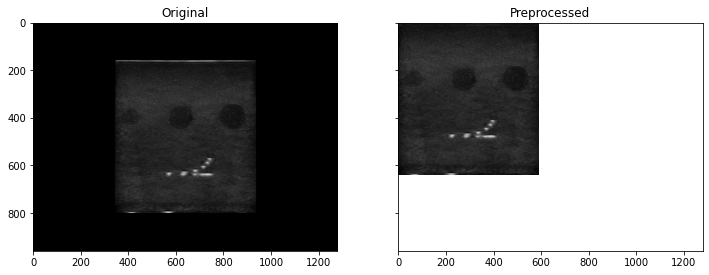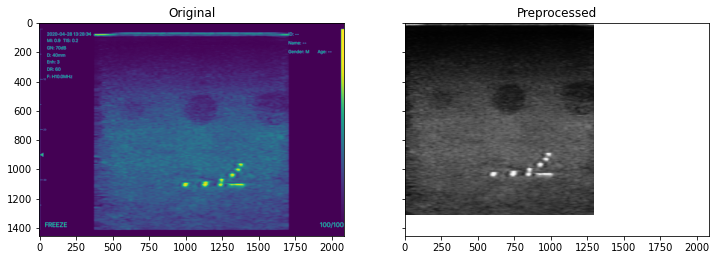Preprocessing images and video
This notebook demonstrates the results of preprocessing for various devices on using images and video from the CIRS 040GSE phantom.
Butterfly
Below shows results for the Butterfly iQ (note, there’s a new Butterfly iQ+). Note, the orientation mark is still visible in the output image as it is too large to median filter. Possible solutions are a more advanced in-filling procedure than the median filter used or cropping the image.
[1]:
import itk
import matplotlib.pyplot as plt
import itkpocus.butterfly as butterfly
import numpy as np
fp = '../tests/data/butterfly_axial-lateral-resolution-2020.png'
orig_img = itk.imread(fp)
new_img, meta = butterfly.load_and_preprocess_image(fp)
fig, axs = plt.subplots(1,2, sharex=True, sharey=True, figsize=(12,10))
axs[1].imshow(new_img, cmap='gray')
axs[1].title.set_text('Preprocessed')
axs[0].imshow(orig_img) # since this is the bigger image, have to plot it last for sharex/y to work
axs[0].title.set_text('Original')
#fig.axes.set_aspect('equal')
print('orig_img: \n\ttype: {}, \n\tspacing: {}, \n\tsize: {}, \n\tmin/max RGB value: {}, {}'.format(
str(type(orig_img)),
str(orig_img.GetSpacing()),
str(orig_img.GetLargestPossibleRegion().GetSize()),
np.min(itk.array_from_image(orig_img)), np.max(itk.array_from_image(orig_img)))
)
print('new_img: \n\ttype: {}, \n\tspacing: {}, \n\tsize: {}, \n\tmin/max value: {}, {}, \n\tmeta: {}'.format(
str(type(new_img)),
str(new_img.GetSpacing()),
str(new_img.GetLargestPossibleRegion().GetSize()),
np.min(itk.array_from_image(new_img)), np.max(itk.array_from_image(new_img)),
str(meta))
)
orig_img:
type: <class 'itk.itkImagePython.itkImageRGBUC2'>,
spacing: itkVectorD2 ([1, 1]),
size: itkSize2 ([1928, 1080]),
min/max RGB value: 0, 255
new_img:
type: <class 'itk.itkImagePython.itkImageF2'>,
spacing: itkVectorD2 ([0.047619, 0.047619]),
size: itkSize2 ([693, 994]),
min/max value: 0.0, 1.0,
meta: {'spacing': array([0.04761905, 0.04761905]), 'crop': array([[ 54, 1048],
[ 614, 1307]])}

Clarius
[2]:
import itk
import matplotlib.pyplot as plt
import itkpocus.clarius as clarius
import numpy as np
fp = '../tests/data/clarius_axial-lateral-resolution-2020.png'
orig_img = itk.imread(fp)
new_img, meta = clarius.load_and_preprocess_image(fp)
fig, axs = plt.subplots(1,2, sharex=True, sharey=True, figsize=(12,10))
axs[1].imshow(new_img, cmap='gray')
axs[1].title.set_text('Preprocessed')
axs[0].imshow(orig_img) # since this is the bigger image, have to plot it last for sharex/y to work
axs[0].title.set_text('Original')
#fig.axes.set_aspect('equal')
print('orig_img: \n\ttype: {}, \n\tspacing: {}, \n\tsize: {}, \n\tmin/max RGB value: {}, {}'.format(
str(type(orig_img)),
str(orig_img.GetSpacing()),
str(orig_img.GetLargestPossibleRegion().GetSize()),
np.min(itk.array_from_image(orig_img)), np.max(itk.array_from_image(orig_img)))
)
print('new_img: \n\ttype: {}, \n\tspacing: {}, \n\tsize: {}, \n\tmin/max value: {}, {}, \n\tmeta: {}'.format(
str(type(new_img)),
str(new_img.GetSpacing()),
str(new_img.GetLargestPossibleRegion().GetSize()),
np.min(itk.array_from_image(new_img)), np.max(itk.array_from_image(new_img)),
str(meta))
)
orig_img:
type: <class 'itk.itkImagePython.itkImageRGBUC2'>,
spacing: itkVectorD2 ([1, 1]),
size: itkSize2 ([1280, 960]),
min/max RGB value: 0, 247
new_img:
type: <class 'itk.itkImagePython.itkImageF2'>,
spacing: itkVectorD2 ([0.714286, 0.714286]),
size: itkSize2 ([592, 642]),
min/max value: 0.0, 0.9686274528503418,
meta: {'spacing': [0.7142857142857143, 0.7142857142857143], 'crop': array([[159, 800],
[344, 935]], dtype=int64)}

Sonoque
[3]:
import itk
import matplotlib.pyplot as plt
import itkpocus.sonoque as sonoque
import numpy as np
fp = '../tests/data/sonoque_axial-lateral-resolution-2020.dcm'
orig_img = itk.imread(fp)
new_img, meta = sonoque.load_and_preprocess_image(fp)
fig, axs = plt.subplots(1,2, sharex=True, sharey=True, figsize=(12,10))
axs[1].imshow(new_img, cmap='gray')
axs[1].title.set_text('Preprocessed')
# sonoque saves as a single-image US series, so we have to remove extraneous 1-element dimensions
axs[0].imshow(itk.array_from_image(orig_img)[0,:,:,0]) # since this is the bigger image, have to plot it last for sharex/y to work
axs[0].title.set_text('Original')
#fig.axes.set_aspect('equal')
print('orig_img: \n\ttype: {}, \n\tspacing: {}, \n\tsize: {}, \n\tmin/max RGB value: {}, {}'.format(
str(type(orig_img)),
str(orig_img.GetSpacing()),
str(orig_img.GetLargestPossibleRegion().GetSize()),
np.min(itk.array_from_image(orig_img)), np.max(itk.array_from_image(orig_img)))
)
print('new_img: \n\ttype: {}, \n\tspacing: {}, \n\tsize: {}, \n\tmin/max value: {}, {}, \n\tmeta: {}'.format(
str(type(new_img)),
str(new_img.GetSpacing()),
str(new_img.GetLargestPossibleRegion().GetSize()),
np.min(itk.array_from_image(new_img)), np.max(itk.array_from_image(new_img)),
str(meta))
)
Unknown encoding 'ISO_IR' - using default encoding instead
orig_img:
type: <class 'itk.itkImagePython.itkImageRGBUC3'>,
spacing: itkVectorD3 ([1, 1, 1]),
size: itkSize3 ([2083, 1455, 1]),
min/max RGB value: 0, 255
new_img:
type: <class 'itk.itkImagePython.itkImageD2'>,
spacing: itkVectorD2 ([0.00291, 0.00291]),
size: itkSize2 ([1293, 1311]),
min/max value: 0.0, 0.9607843137254902,
meta: {'spacing': (0.00291, 0.00291), 'crop': array([[ 72, 1382],
[ 395, 1687]], dtype=int64)}

Interson
Coming Soon!
Sonivate
Sonivate currently doesn’t allow direct retrieval of ultrasound images from its device. We recommend streaming the probe to Slicer and then saving from Slicer.
[ ]: